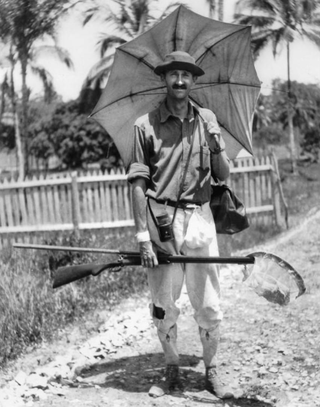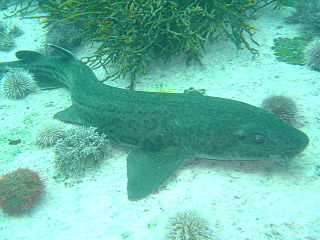
Ctenophora comprise a phylum of marine invertebrates, commonly known as comb jellies, that inhabit sea waters worldwide. They are notable for the groups of cilia they use for swimming, and they are the largest animals to swim with the help of cilia.

Bioluminescence is the production and emission of light by living organisms. It is a form of chemiluminescence. Bioluminescence occurs widely in marine vertebrates and invertebrates, as well as in some fungi, microorganisms including some bioluminescent bacteria, and terrestrial arthropods such as fireflies. In some animals, the light is bacteriogenic, produced by symbiotic bacteria such as those from the genus Vibrio; in others, it is autogenic, produced by the animals themselves.

CharlesWilliam Beebe was an American naturalist, ornithologist, marine biologist, entomologist, explorer, and author. He is remembered for the numerous expeditions he conducted for the New York Zoological Society, his deep dives in the Bathysphere, and his prolific scientific writing for academic and popular audiences.

The comb duck or American comb duck, is an unusual duck, found in tropical wetlands in continental South America south to the Paraguay River region in eastern Paraguay, southeastern Brazil and extreme northeastern Argentina, and as a vagrant on Trinidad.

The winghead shark is a species of hammerhead shark, and part of the family Sphyrnidae. Reaching a length of 1.9 m (6.2 ft), this small brown to gray shark has a slender body with a tall, sickle-shaped first dorsal fin. Its name comes from its exceptionally large "hammer", or cephalofoil, which can be as wide as half of the shark's total length. The function of this structure is unclear, but may relate to the shark's senses. The wide spacing of its eyes grants superb binocular vision, while the extremely long nostrils on the leading margin of the cephalofoil may allow for better detection and tracking of odor trails in the water. The cephalofoil also provides a large surface area for its ampullae of Lorenzini and lateral line, with potential benefits for electroreception and mechanoreception, respectively.

The European sprat, also known as bristling, brisling, garvie, garvock, Russian sardine, russlet, skipper or whitebait, is a species of small marine fish in the herring family Clupeidae. Found in European waters, it has silver grey scales and white-grey flesh. Specific seas in which the species occurs include the Irish Sea, Black Sea, Baltic Sea and Sea of the Hebrides. The fish is the subject of fisheries, particularly in Scandinavia, and is made into fish meal, as well as being used for human consumption. When used for food it can be canned, salted, breaded, fried, boiled, grilled, baked, deep fried, marinated, broiled, and smoked.

The Wildlife Conservation Society (WCS) is a 501(c)(3) non-governmental organization headquartered at the Bronx Zoo in New York City, that aims to conserve the world's largest wild places in 14 priority regions. Founded in 1895 as the New York Zoological Society (NYZS), the organization is now led by President and CEO, Monica P. Medina, who replaced long time President and CEO Cristián Samper in 2023. WCS manages four New York City wildlife parks in addition to the Bronx Zoo: the Central Park Zoo, New York Aquarium, Prospect Park Zoo and Queens Zoo. Together these parks receive 4 million visitors per year. All of the New York City facilities are accredited by the Association of Zoos and Aquariums (AZA).

A zoophyte (animal-plant) is an obsolete term for an organism thought to be intermediate between animals and plants, or an animal with plant-like attributes or appearance. In the 19th century they were reclassified as Radiata which included various taxa, a term superseded by Coelenterata referring more narrowly to the animal phyla Cnidaria, sponges, and Ctenophora.

The Bathysphere was a unique spherical deep-sea submersible which was unpowered and lowered into the ocean on a cable, and was used to conduct a series of dives off the coast of Bermuda from 1930 to 1934. The Bathysphere was designed in 1928 and 1929 by the American engineer Otis Barton, to be used by the naturalist William Beebe for studying undersea wildlife. Beebe and Barton conducted dives in the Bathysphere together, marking the first time that a marine biologist observed deep-sea animals in their native environment. Their dives set several consecutive world records for the deepest dive ever performed by a human. The record set by the deepest of these, to a depth of 3,028 ft (923 m) on August 15, 1934, lasted until it was broken by Barton in 1949 in a vessel called Benthoscope.

The leopard catshark is a species of catshark, and part of the family Scyliorhinidae, endemic to the coastal waters of South Africa. Abundant in inshore waters under 20 m (66 ft) deep, this bottom-dweller favors rocky reefs, kelp beds, and sandy flats. Growing to a length of 84 cm (33 in), the leopard catshark has a stout body with two dorsal fins placed well back, and a short head and tail. It is extremely variable in color and pattern, with individuals ranging from almost white to black and covered by diverse patterns of black spots, blotches, rosettes, and/or lines. The color pattern changes with age and some forms seem to be location-specific, suggesting the presence of multiple distinct, local populations. In the past, some of the more distinct color forms have been described as different species.

The splendid lanternshark is a shark of the family Etmopteridae found in the western Pacific at depths between 120 and 210 m. Through the classification of Etmopterus species into several clades based on the positioning of their bioluminescent photophores, the splendid lanternshark can be considered a member of the Etmopterus pusillus clade.

Deepstaria enigmatica is a very rarely seen giant jellyfish of the family Ulmaridae first described in 1967 by F. S. Russell.

Ctenochaetus, or bristletooth tangs, is a genus of marine ray-finned fish belonging to the family Acanthuridae, which includes the surgeonfishes, unicornfishes and tangs. These fishes are found in the Indo-Pacific region. They have many, small flexible teeth and some species have the common name bristletooth.

The Drilliidae are a taxonomic family of small predatory sea snails with high-spired shells. They are classified as marine gastropod mollusks in the superfamily Conoidea.

Gelae is a genus of round fungus beetles belonging to the family Leiodidae. The beetles are found in different parts of Central and North America. They are small and rounded, feeding on slime moulds. They were originally placed in the genus Agathidium following the discovery of the first species, G. cognatum, in 1878. The taxonomic position was revised with description of new species in 2004 by American entomologists Kelly B. Miller and Quentin D. Wheeler. Upon creation of the new genus, the five new species are Gelae baen, G. belae, G. donut, G. fish, and G. rol.

Bolinopsis infundibulum, commonly known as the common northern comb jelly, is a species of comb jelly in the family Bolinopsidae. It is found in the northern Atlantic Ocean and was first described by the Danish naturalist Otto Friedrich Müller in 1776.

Else Winkler von Röder (Roeder) Bostelmann (1882-1961), a German Empire-born American artist, joined the New York Zoological Society in 1929 to paint marine life during William Beebe's bathysphere oceanographic expeditions at Bermuda's Nonsuch Island (1930-1934).
Pseudorhiza haeckeli, or Haeckel's jelly, is a species of cnidarian of the family Lychnorhizidae. The species is a carnivore with a mild sting. It is native to temperate and sub-tropical Australian marine waters. It has been observed at depths of 1-30 metres, and is sometimes found cast on beaches. It was described by the naturalist Wilhelm Haacke in 1884, and named for his mentor Ernst Haeckel.

"Bathysphaera intacta", the "giant dragonfish" is species of fish that was described by William Beebe on 22 September 1932, being spotted by the biologist as he descended to a depth of 640 metres of the coast of Bermuda .

Bathyembryx istiophasma, the pallid sailfin, is hypothetical species of fish observed by William Beebe on 11 August 1934. He describing seeing the species twice during the same dive at depths of 1,500 feet (460 m) and 2,500 feet (760 m) near the coast of Bermuda.




















